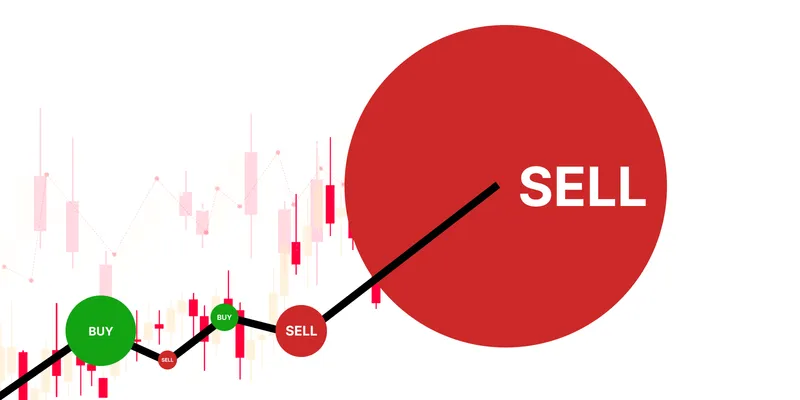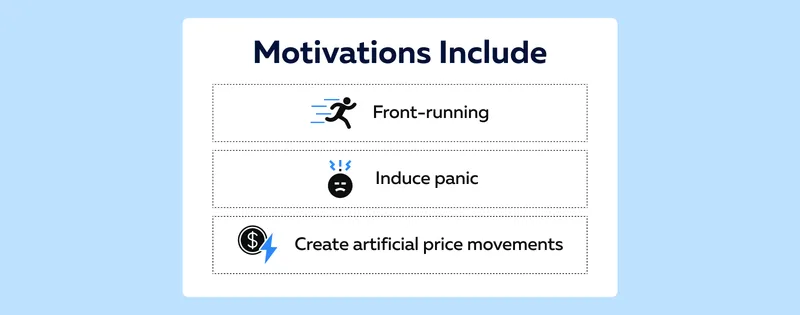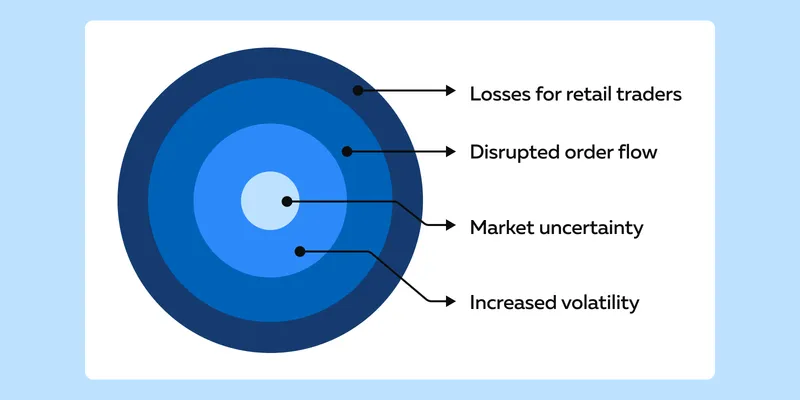Ready to see the market clearly?
Sign up now and make smarter trades today
Education
April 2, 2024
SHARE
How Larger Players Use Quote Stuffing to Gain an Edge in Trading
Imagine you’re watching a stock’s price soaring high, and you decide to buy it. But as soon as you do, the price drops sharply, and you’re left with a loss. If so, you might have been tricked by a tactic known as “quote stuffing”. It is a tricky strategy that involves sending fake orders thereby creating confusion and volatility in the market and disrupting the normal flow of trading.
In this article, we will explore the mechanics of quote stuffing, how it influences market dynamics, and the motivations behind it. Understanding this is crucial for traders because it can lead to increased market volatility and challenges, especially for those without high-speed technology.
Also, we will see how traders and regulators are working together to detect and mitigate quote stuffing. By being aware of these strategies and the efforts to control them, you can become a more informed trader. Let’s get started.
What is Quote Stuffing?

Quote stuffing is a trading strategy employed by market participants to gain an advantage by placing an exceptionally high volume of orders or quotes. This is perceived as a tactic and is characterized by its rapid execution. The primary goal of quote stuffing is to create chaos and exploit fleeting opportunities in the market.
How Is Quote Stuffing Practiced?
Traders execute quote stuffing by flooding the market with an excessive number of orders or quotes in a short timeframe. The objective is not necessarily to execute these orders but to:
- Create confusion,
- Disrupt normal trading activities, and
- Potentially mislead other market participants.
Read the table below to understand the complete process:
| Steps | Explanation |
| Entering Orders | Quote stuffing begins with high-frequency traders (HFT) entering an exceptionally large number of buy or sell orders for stocks. |
| Immediate Cancellation | Following the entry of orders, these traders swiftly cancel the orders without allowing them to be executed. |
| Massive Volume |
|
| Impact on Bid and Ask Spread | The sheer volume of orders is intended to:
|
| Market Manipulation | Traders perform quote stuffing to impact the stock’s market price and profit from the manipulated conditions. |
In this modern era, traders practice quote stuffing through various means, including the use of algorithms and automated trading systems.
The Role of Technology and Algorithms
Quote stuffing relies heavily on advanced technology and algorithms, which execute orders at speeds beyond human capability. These are designed to:
- Analyze market data and
- Execute trades at incredibly fast speeds (often measured in milliseconds or microseconds).
Automated trading systems enable traders to send a large number of orders or quotes within fractions of a second. These systems can rapidly adjust to changing market conditions and exploit price discrepancies or other opportunities that arise during the brief period of quote stuffing.
How Quote Stuffing Appears in Real-time Trading Data
It appears as sudden spikes in order volume or a surge in quote updates within a very short timeframe. Such an appearance is visible because, in quote stuffing, traders flood the market with a barrage of buy or sell orders, only to cancel them shortly after.
For Example,
- A trader submits thousands of buy orders for a specific stock at different price levels.
- This causes sudden spikes in real-time trading data.
- An illusion of high demand is created.
- Before these orders can be executed, the trader swiftly cancels them and takes advantage of the confusion caused in the market.
The Motivations Behind Quote Stuffing

One primary motivation behind quote stuffing is the desire to front-run other traders by creating an illusion of high demand. Traders caught in the trap, react to the apparent trend and believe that there is increased buying or selling interest in a particular stock.
This allows the quote stuffer to anticipate and capitalize on their subsequent trades. In most cases, quote stuffers gain an advantage over less informed market participants.
Additionally, they intend to:
- Induce Panic in the Market
-
-
- By rapidly executing and canceling a large number of orders, a trader creates an atmosphere of uncertainty and confusion.
- This order flooding creates panic and leads to reactionary trades from other market participants.
- A quote stuffer profits from the ensuing volatility by forcing others to make impulsive decisions.
-
- Create Artificial Price Movements:
-
- Through the sheer volume of orders or quotes, quote stuffers briefly distort supply and demand dynamics.
- They trigger automated trading algorithms and force them to execute trades at unfavorable prices.
- This manipulation of price movements is exploited by the quote stuffer for financial gains.
The Mechanics Behind Quote Stuffing
As discussed earlier, quote stuffing involves the rapid inundation of the market with an excessive number of orders or quotes within a short time frame. Most quote stuffers, execute this tactic using advanced technology and algorithms, particularly through High-Frequency Trading (HFT) strategies.
High-Frequency Trading (HFT) algorithms are computerized trading strategies that execute a large number of orders at extremely high speeds. Let’s understand how these algorithms work:
| Steps | Explanation |
| Market Events Triggering Orders | HFT algorithms analyze market events or triggers, such as
|
| Rapid Order Placement | These place a large number of orders or trades in microseconds or even nanoseconds. |
| Sudden Surge in Order Volume | When multiple HFT algorithms simultaneously respond to the same market event, there is a sudden and massive surge in order volume. |
How Low-Frequency Traders Get Impacted
Low-frequency (LF) traders, typically operate at a slower pace and rely on more traditional trading strategies. They are severely affected by quote stuffing as rapid and excessive order flow initiated by HFT algorithms creates a challenging environment for LF traders.
The increased volatility and distorted market conditions lead to:
- Impaired visibility and access to the market,
- Missed trading opportunities,
- Potentially adverse trading outcomes, and
- Impulsive decision making.
How Do Technology and Automated Trading Systems Help Quote Stuffers?
The technology behind quote stuffing involves sophisticated automated trading systems. These systems execute a predefined set of actions based on market conditions. Traders using automated systems set parameters for quote stuffing, specifying the:
- Volume,
- Speed, and
- Duration of orders.
This level of automation allows for the rapid deployment and cancellation of orders. Also, it must be noted that quote-stuffing algorithms use “randomization techniques” to conceal their patterns and intentions. By introducing randomness in the timing and size of orders, these algorithms attempt to evade detection by surveillance systems that look for suspicious trading behavior.
Let’s understand quote stuffing through a hypothetical example:
- Under normal market conditions
- Stock XYZ is currently trading at $50 per share.
- The bid-ask spread is $49.90 (bid) – $50.10 (ask).
- Trader A decides to flood the market with fake orders and initiated quote stuffing.
- They rapidly place many fake orders on both the buy and sell sides.
| Buy Side Quote Stuffing | Sell Side Quote Stuffing |
|
|
|
|
-
- Due to quote stuffing,
- The order book is impacted:
- It becomes flooded with Trader A’s fake orders.
- Other traders feel there is substantial activity in the market.
- They interpret this increased activity as a sign of strong interest in buying and selling.
- The bid-ask spread is also impacted impacted:
- The bid-ask spread tightens due to the increased number of buy and sell orders in close proximity to the current market price.
- This attracts other traders looking to capitalize on what seems like a narrowing spread.
- The order book is impacted:
- Due to quote stuffing,
- What is the intent of Trader A?
- Trader A’s primary goal is not to execute these orders but to:
- Create confusion and
- Manipulate market perceptions.
- By triggering reactions from other market participants, Trader A aims to benefit from subsequent price movements.
- Ceasing Quote Stuffing:
- After achieving the desired confusion or reaction from other market participants, Trader A ceases quote stuffing.
- Potential Action of Trader A:
- May choose to execute actual trades based on the market’s reaction to the fake orders.
- May have achieved the desired impact on the market without executing any real trades.
The Impact on Market Dynamics

Quote stuffing affects order flow, volatility, and the experiences of various market participants. One of the immediate consequences of quote stuffing is the escalation of market volatility. The rapid influx and cancellation of a large number of orders create:
- An environment of uncertainty and,
- Abrupt price movements.
Traders, both automated and human, react to the perceived shifts in supply and demand. This leads to increased volatility, which can be exploited by quote stuffers for short-term gains, further destabilizing the market. Furthermore, quote stuffing impacts the market dynamics by:
- Disrupting Order Flow
-
-
- Quote stuffing disrupts the normal flow of orders in the market.
- The overwhelming number of orders creates congestion in the exchange’s order book.
- This congestion leads to delays in order processing and impacts the ability of traders to execute orders at desired prices.
-
- Creating Challenges for Retail Traders
-
- Retail traders often lack the speed and technological resources of institutional and high-frequency traders.
- The rapid and artificial price movements induced by this strategy catch retail traders off guard and lead to:
- Suboptimal trade executions,
- Increased trading costs, and
- Potential losses.
A Real-life Market Event
In the “Flash Crash” of May 6, 2010, the U.S. major stock indices experienced a sudden and severe drop in a matter of minutes, followed by a rapid recovery. The Dow Jones Industrial Average (DJIA) plummeted nearly 1,000 points, or about 9%, within a very short time frame, only to recover a significant portion of those losses shortly thereafter.
How did the Market Crash?
Based on several theories and research reports, it has been found that:
- High-Frequency Trading (HFT) algorithms were programmed to respond to market conditions.
- A series of rapid and large trades were executed by HFT systems to exacerbate the selling pressure.
- As a result of the rapid sell-off, liquidity in the market temporarily evaporated.
- Due to the liquidity crunch, fewer buyers were willing to match the selling orders. This event caused prices to drop rapidly.
Strategies & Techniques
Larger players often use high-frequency trading (HFT) algorithms and sophisticated tools, to exploit market conditions and disrupt the trading activities of others. Let’s understand some common strategies and techniques:
- Order Randomization:
- To evade detection and minimize predictability, some quote-stuffing algorithms use randomization techniques.
- This involves introducing variability in the size and timing of orders.
- Variability makes it more challenging for surveillance systems to identify patterns associated with quote stuffing.
- Cancelation and Modification:
- Quote stuffing is characterized by:
- Rapid placement,
- Cancellation, and
- Modification of orders.
- After flooding the order book with a substantial number of orders, these orders are quickly canceled.
- The purpose is not to execute trades but to:
- Create chaos,
- Disrupt market participants, and
- Exploit inefficiencies in the market.
- Quote stuffing is characterized by:
- Obfuscation Techniques:
-
-
- Sophisticated quote-stuffing strategies involve obfuscation techniques to hide the true intent behind the flood of orders.
- This could include using multiple accounts or routing orders through different brokers.
- This strategy makes it more challenging for regulators to trace the activity back to a specific entity.
-
- Regulatory Arbitrage:
-
- Quote-stuffing strategies attempt to exploit gaps or weaknesses in regulatory frameworks.
- Regulatory authorities continuously adapt to emerging challenges, but sophisticated quote stuffers stay ahead by adapting their strategies to exploit regulatory loopholes.
The Regulatory Landscape

It’s evident that quote stuffing creates confusion, slows down the trading system, and potentially manipulates market prices. Thus, regulators have identified it as a manipulative trading practice and have taken measures to address it within the regulatory framework.
Any activity detrimental to the integrity of financial markets enforces regulatory agencies to take strict enforcement actions against individuals and entities engaged in such practices. These actions include fines, suspensions, and other penalties.
Let’s read about the two most prominent regulatory agencies operating in the US in the table below:
| Securities and Exchange Commission (SEC) | Commodity Futures Trading Commission (CFTC) |
|
|
Real-World Quote Stuffing Cases
For a better understanding, explore some specific legal cases and enforcement actions related to quote stuffing below:
1. The 2010 Quote Stuffing Case
In 2010, the U.S. Securities and Exchange Commission (SEC) probed certain practices around “quote stuffing,” where large numbers of rapid-fire stock orders were placed. The then SEC Chairman, Mary Schapiro, mentioned that regulators were examining these practices to assess whether they violated existing rules against fraudulent or improper behavior. Read the complete details from here.
2. The Trillium Capital Case
In 2010, Trillium Capital, a high-frequency trading firm in New York, was fined by the Financial Industry Regulatory Authority (FINRA) for quote stuffing and market manipulation. The firm and several individuals were fined and suspended for their involvement in quote stuffing and market manipulation. Read the complete details from here.
3. SEC v. In the Matter of Swift Trade Inc. (2011)
This case involved allegations of manipulative trading, including quote stuffing, by a proprietary trading firm. The SEC imposed a significant penalty against Swift Trade Inc. for engaging in these practices. Read the complete details from here.
4. CFTC v. Panther Energy Trading LLC et al. (2014)
In this case, the CFTC charged Panther Energy Trading LLC and its principal with engaging in manipulative and deceptive conduct, including quote stuffing, in the commodity futures markets. Read more details here.
Detecting & Mitigating Quote Stuffing
Detecting and mitigating the impact of quote stuffing helps in maintaining the integrity and fairness of financial markets. Traders, market participants, exchanges, and regulatory bodies play pivotal roles in identifying and addressing the disruptive effects of this trading strategy. Surveillance technology and data analysis have played a key role in identifying quote-stuffing patterns. Let’s understand how they are helping traders.
Surveillance Technology and Data Analysis
- Algorithmic Pattern Recognition
-
-
- Traders and exchanges employ sophisticated surveillance technology to analyze market data for unusual patterns indicative of quote stuffing.
- Algorithms are programmed to detect:
- Rapid order placement and
- Cancellation cycles.
- Advanced data analysis tools scrutinize:
- Order book dynamics,
- Trading volumes, and
- Order-to-trade ratios.
- This scrutiny helps to identify anomalies that suggest disruptive trading practices.
-
- Machine Learning and Artificial Intelligence:
-
- Currently, machine learning models and artificial intelligence (AI) systems are widely used to spot complex patterns associated with quote stuffing.
- These systems learn from historical data and adapt to evolving market conditions.
- This evolution improves their detection capabilities over time.
How Important is Real-Time Monitoring?
Real-time monitoring is critical for the timely detection of quote stuffing. When abnormal trading activities are detected, automated alert systems notify:
- Traders,
- Exchanges, and
- Regulators.
These systems are usually configured to trigger alerts based on predefined thresholds, such as a sudden surge in order cancellations or an unusually high order-to-trade ratio.
The Role of Market Surveillance Teams
Exchanges often have dedicated market surveillance teams that actively monitor trading activities. These teams use a combination of automated tools and human expertise to identify and investigate suspicious behavior. Real-time collaboration between market surveillance teams and regulatory bodies helps in prompt detection, intervention, and taking enforcement actions when quote stuffing is detected.
Conclusion
The disruptive strategy of quote stuffing poses challenges for traders and investors. It involves overwhelming the market with too many orders, leading to increased market volatility, causing chaos, and impacting market dynamics.
High-frequency trading algorithms play a major role in executing this tactic. To address this, surveillance technology and real-time monitoring are crucial tools for detecting and mitigating quote stuffing. Also, traders need to stay informed about regulatory changes and technological advancements to adapt and contribute to maintaining a fair and transparent financial market.
At Bookmap, we believe in providing traders with the knowledge they need to navigate complex trading environments. If you’re interested in understanding how high-frequency trading influences order flow, check out our in-depth article on the topic: Navigating the Market: High-Frequency Trading Influence on Order Flow Explained. It’s a valuable resource for traders looking to gain deeper insights into market dynamics.
